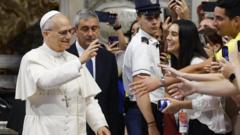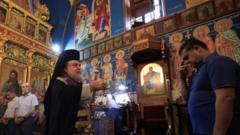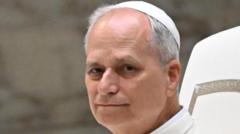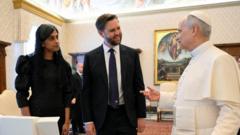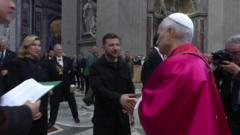Pope Leo XIV’s inauguration reflects significant shifts away from long-held papal coronation traditions that once emphasized a crown's symbolization of temporal power.
Pope Leo XIV Marks a New Era in Papal Traditions

Pope Leo XIV Marks a New Era in Papal Traditions
Inaugural Mass Brings Historical Changes to Papal Ceremonies
In a striking departure from centuries of tradition, Pope Leo XIV commenced his papacy with an inaugural Mass on Sunday that redefined the significance of the pontifical ceremony. Historically, this occasion would often include an elaborate coronation, where the pope would don a gold and jewel-adorned tiara, a practice that persisted until Pope Paul VI chose to cease its use in 1964. Instead of focusing on ceremonial grandeur, contemporary popes have opted for a more humble representation, choosing to wear a simple miter during liturgical ceremonies.
Reflecting on the transition from grand coronations to simpler Masses, Rev. Stefano Sanchirico explained, "The tiara would only be worn during specific solemn events, not during liturgical functions." Following the tiara's discontinuation, it found a resting place in the United States, showcasing the Vatican's shift towards modernity under Paul VI's leadership.
Pope John Paul II notably acknowledged this shift in his inaugural Mass, emphasizing that the focus should be directed away from traditional symbols reflecting power. "We should not revert to ceremonies considered to symbolize the temporal power of the Popes," he stated on October 22, 1978.
Archival footage from past papal coronations reveals the pageantry that has now become a relic of history. For instance, a 1939 film captures the crowning of Pope Pius XII amidst the jubilant cheers of crowds in St. Peter’s Square, a stark contrast to the more introspective celebrations of contemporary papacies. The coronation of Pope John XXIII in 1958 further highlighted the tradition before it was ultimately abandoned.
As the Vatican adapts to new societal contexts, Pope Leo XIV’s inaugural Mass signals an ongoing evolution in how papal authority is expressed and perceived in the modern era, reflecting broader themes of humility and connection to the faithful community.
Reflecting on the transition from grand coronations to simpler Masses, Rev. Stefano Sanchirico explained, "The tiara would only be worn during specific solemn events, not during liturgical functions." Following the tiara's discontinuation, it found a resting place in the United States, showcasing the Vatican's shift towards modernity under Paul VI's leadership.
Pope John Paul II notably acknowledged this shift in his inaugural Mass, emphasizing that the focus should be directed away from traditional symbols reflecting power. "We should not revert to ceremonies considered to symbolize the temporal power of the Popes," he stated on October 22, 1978.
Archival footage from past papal coronations reveals the pageantry that has now become a relic of history. For instance, a 1939 film captures the crowning of Pope Pius XII amidst the jubilant cheers of crowds in St. Peter’s Square, a stark contrast to the more introspective celebrations of contemporary papacies. The coronation of Pope John XXIII in 1958 further highlighted the tradition before it was ultimately abandoned.
As the Vatican adapts to new societal contexts, Pope Leo XIV’s inaugural Mass signals an ongoing evolution in how papal authority is expressed and perceived in the modern era, reflecting broader themes of humility and connection to the faithful community.


